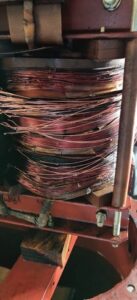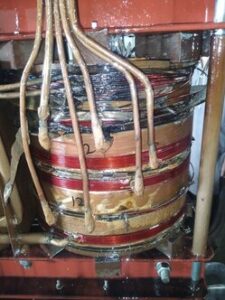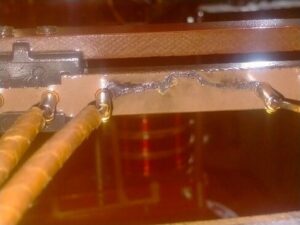
How to identify the abnormal operation of the three-phase distribution and power Transformer and 14 Basic
Transformer faults in transformer operation.
1-The transformer’s sound is unusual or abnormal.
(a) The sound of the transformer is uniform and louder than normal, or > 70 dB. The following explanations are possible:
(b) Overvoltage can happen on the load side or in the power grid. The transformer will become noisier and hotter if there is a single-phase grounding in the power grid or a resonance overvoltage.

(c) If the transformer is overloaded too much,
The transformer will vibrate and produce a loud “hum.” If the transformer’s load is observed to be higher than the permissible normal overload value, the load should be decreased in accordance with local regulations. The best action to take is to examine the root causes, keep notes, improve monitoring, and ensure that the load is distributed evenly throughout each phase. and as quickly as possible, return the transformer to normal operation. If overload was the root of the problem, the overload treatment method must be followed.
2) The transformer produces a high noise
Vibrations might be generated by the transformer’s loose components. If the transformer’s noise level is consistently higher yet the current and voltage are normal, possible causes include a missing core clamping road, other accessories loosening, or a screw pressing on the iron core, which causes the silicon steel sheet to vibrate more. Treatment method: If it doesn’t affect the transformer’s operations, it may be temporarily ignored. Instead, records can be made, monitoring can be strengthened, reports can be sent out, and requests can be produced for the necessary leaders to investigate and handle power failures.
3) The transformer faults makes a discharge sound.
There is a “cracking” discharge sound coming from the transformer. It is a sign that the equipment line cards are in poor condition or are losing contact if you observe a blue corona or sparks close to the transformer bushing at night or in bad weather. The electrostatic discharge of the unground components, the coil’s inter-turn discharge, or the discharge produced by the tap changer’s weak contact are all possible causes of an internally discharged transformer. Solution: The dispatcher and pertinent leaders should be informed to request a transformer power failure inspection at this time.
4) The transformer makes a popping sound.
indicates that the transformer’s internal or external insulation is damaged, and the transformer should be disconnected immediately for inspection.
5) The transformer produces a sound similar to that of boiling water.
(a) The transformer warns of oncoming overheating. It needs an appropriate tank or cooling space.
- The temperature of the top oil is high. It’s possible that the cooling tube opening is not clear or that the oil in the tank is not circulating properly.
- The oil’s colour is abnormal.
- The oil level is considerably lower than specified or indicated.
- The Buchholz relay will activate an alert if the transformer is overloaded or the current value exceeds the designed or specified value.
- Failure of the cooling system
- The gas protection will activate on and send a signal.
- During operation, high-temperature parts will also be gradually built.
- Windings, bushings, tap-changers, iron cores, oil tanks, and other accessories are commonly faulty in operational transformers.
6) A failed winding.
Inter-turn short circuits, winding grounding, inter-phase short circuits, wire breakage, and joint welding are the most appropriate and relevant.
The following are the causes of these failures:
- Local insulation is damaged during production or maintenance, producing weak points:
- Items that fall into the windings during operation because of insufficient heat dissipation or prolonged overload raise the temperature and increase the ageing of the insulation;
- The winding is damaged, the insulation is damaged, the pressing is not tight enough to survive to short-circuit impact, and the mechanical strength is unsatisfactory;
7) Casing failure.
When there are pollution flashovers in poor visibility or light rain, the transformer bushing becomes fouled, which causes to single-phase grounding or phase-to-phase short circuits on the high-voltage side of the transformer.
Such failures are frequent in explosions, flashovers, and oil spills, and the causes are:
1.Bad sealing, poor insulation against moisture, or oil leakage
2. The respirator is set up improperly, or the moisture inhaled is not immediately dealt with
3. The high-voltage side of the transformer (110kV and above) normally uses capacitor bushings, and there are trachoma or cracks due to poor porcelain quality
4.The casing is severely fouled.
8) Serious leakage.
In order for the oil level gauge to no longer be able to observe the oil level, the transformer’s oil leak is either serious or regularly overflowing from the damaged area. The transformer should now be stopped right away so that the leak can be fixed and fuel may be added. The transformer’s oil leak is caused by a welding seam that has broken or failed to close. When operating, vibration and external force cause the parts to malfunction, significantly corroding and damaging the fuel tank.
9) Tap changer failure.
Poor contact or incorrect positioning of the tap changer are common defects, as are melting and burns on the contact surface, discharge of the interphase contacts, and discharge of each tap.

The primary causes are:
- There are loose connection screws.
- The belt load adjustment mechanism was inappropriately and badly adjusted.
- The tap insulation board is improperly insulated.
- The spring pressure is insufficient, the contact is weak, the manufacturing process is substandard, and the joint solder is not satisfactory.
10) Failure due to overvoltage.
Due to the high possibility of lightning, while a transformer is in use, it will generate overvoltage outside the transformer. Electromagnetic oscillation causes some power system parameters to vary, which results in overvoltage inside the transformer. The main winding insulation breakdown that results in transformer failure accounts for the majority of overvoltage-induced transformer damage.
11) Failure of the iron core.
— usually, the through-core screw of the iron core column or the clamping screw of the iron core suffers insulation damage, but there are other factors that contribute to iron core failure as well, which are listed below.
The iron core becomes partially overheated and melted due to the following three factors:
1. The insulation between the silicon steel sheets is damaged
2. The insulation of the through-bolt that is clamping the iron core is damaged
3. Residual welding slag creates the two-point grounding of the iron core.
12) The oil leaking occurrence.
The bushing leads and the tap changer are exposed to the air when the transformer oil level is too low, which significantly lowers the insulation level and makes breakdown discharge extremely likely.
13) Weak gas protection
The primary safeguard for the transformer is gas protection; mild gas affects the signal, while strong gas affects tripping. Below is an analysis of the causes and potential solutions for gas protection measures:
1. The oil filter, refuelling, and cooling systems may not be well sealed, which may be the cause of the gas protection action
2. The oil level gradually drops owing to a decline in temperature and oil leakage, or a tiny quantity of gas is produced due to transformer failure.
14) Transformer catches fire
A dangerous accident is a transformer fire. The transformer includes a lot of flammable materials, so if the fire is not put out quickly enough, it might blow up or spread.
The two main causes of transformer fires are:
1. The casing is damaged and flashes off, allowing the oil to flow out and burn on the top cover under the pressure of the oil pillow
2. An internal transformer fault tears open the casing or the radiator, allowing the burning hot transformer oil to overflow.
15)𝐃𝐞𝐭𝐞𝐜𝐭𝐢𝐨𝐧 𝐨𝐟 𝐦𝐞𝐭𝐚𝐥𝐬 𝐢𝐧 𝐭𝐫𝐚𝐧𝐬𝐟𝐨𝐫𝐦𝐞𝐫 𝐨𝐢𝐥
When a gas-in-oil study has shown that an internal problem is in progress, the detection of metals in low concentration in transformer oil can help pinpoint the site of the fault or identify excessive wear in oil circulation pumps. Commonly, these metals include tin, zinc, lead, silver, copper, aluminium, iron, and copper.
Metals linked to certain faults are present due to various fault types. Finding the defect site can be addressed by learning from the manufacturer which metals are utilised where in the transformer. The following Table illustrates how various metals are often used in transformers.
Since there are currently no standards for allowable metal concentrations in oil, it is essential to establish a baseline of values for a specific transformer. The dissolved gas-in-oil analysis and subsequent variations from the baseline values detected help identify the kind and location of an upcoming fault.

Leave a Reply